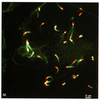| dc.contributor.author | Golsteyn, RM | fr_FR |
| dc.contributor.author | Arpin, M | fr_FR |
| dc.contributor.author | Friederich, E | fr_FR |
| dc.contributor.author | Louvard, D | fr_FR |
| dc.date.accessioned | 2012-08-30T12:33:02Z | |
| dc.date.available | 2012-08-30T12:33:02Z | |
| dc.date.issued | 2000 | fr_FR |
| dc.identifier.citation | Golsteyn, RM ; Arpin, M ; Friederich, E ; Louvard, D, Les protéines du cytosquelette d'actine : bien placées pour la motilité., Med Sci (Paris), 2000, Vol. 16, N° 6-7; p.722-31 | fr_FR |
| dc.identifier.issn | 1958-5381 | fr_FR |
| dc.identifier.uri | http://hdl.handle.net/10608/1723 | |
| dc.description.abstract | Les cellules d'un organisme
sont animées par une très grande
variété de mouvements, qui
nécessitent la coordination d'un
réseau complexe de protéines
formant le cytosquelette d'actine.
Au centre de ce réseau se trouve
l'actine, qui possède des
propriétés dynamiques
intrinsèques, grâce à sa capacité
de former un long polymère à
partir de monomères. Dans cette
revue, nous discuterons trois
systèmes différents qui règlent
l'organisation du cytosquelette d'actine. Deux d'entre eux sont
importants pour le contrôle de la
polymérisation de l'actine dans
des structures cellulaires
différentes : l'un dépend du
complexe Arp2/3, l'autre de la
zyxine. Le troisième est
représenté par la protéine ezrine
qui, par son interaction avec les
protéines membranaires et les
filaments d'actine, peut régler
l'organisation du cortex cellulaire
en affectant la motilité et la
survie. | fr |
| dc.description.abstract | The cells of our body are capable of a tremendous variety of movements that require the coordination of the actin cytoskeleton, a complex network of proteins. At the heart of this network, actin is attributed with the dynamic properties of alternating between a monomer and a long polymer chain. One of the major problems in biology has been to understand how the simple process of actin polymerisation and depolymerisation can orchestrate the complex cell movement necessary for embryogenesis, immune response, and wound repair. In this review, we focus on three different, but related systems that play a major role in regulating the actin cytoskeleton. Two of these systems, represented by the Arp2/3 complex and zyxin, appear to be important in controlling actin polymerisation by different mechanisms acting at different locations in the cell. A third major system is represented by ezrin, which, in addition to its direct interaction with actin, can regulate the actin cytoskeleton and affect cell movement and survival. To unravel the complexities of cell movement and the actin cytoskeleton has been a major challenge, but the use of many different experimental systems has now given us an integrated view of cell motility. | en |
| dc.language.iso | fr | fr_FR |
| dc.publisher | Masson, Paris | fr_FR |
| dc.rights | Article en libre accès | fr |
| dc.rights | Médecine/Sciences - Inserm - SRMS | fr |
| dc.source | M/S. Médecine sciences [revue papier, ISSN : 0767-0974], 2000, Vol. 16, N° 6-7; p.722-31 | fr_FR |
| dc.title | Les protéines du cytosquelette d'actine : bien placées pour la motilité. | fr |
| dc.title.alternative | The proteins of the actin cytoskeleton: Well placed for motility. | fr_FR |
| dc.type | Article | fr_FR |
| dc.contributor.affiliation | CNRS UMR 144 Institut Curie Section Recherche 26, rue d'Ulm 75248 Paris Cedex 05 Daniel.Louvard@curie.fr | - |
| dc.identifier.doi | 10.4267/10608/1723 | |









